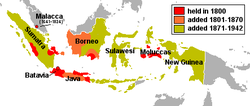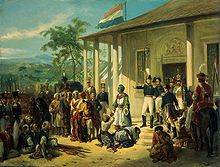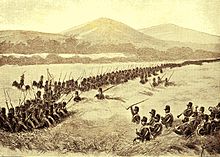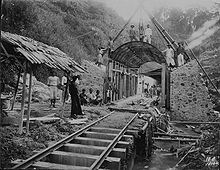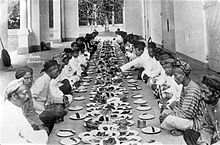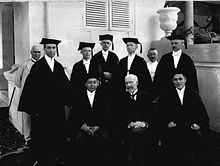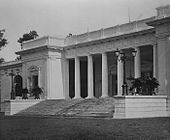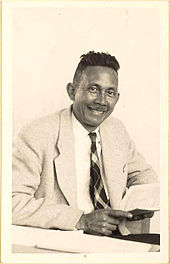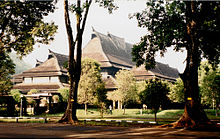- Dutch East Indies
-
Dutch East Indies Dutch colony ← 
←
1800–1942
1945–1949* →
→
 →
→
 →
→

Flag Coat of arms Map of the Dutch East Indies showing its territorial expansion from 1800 to its fullest extent prior to Japanese occupation in 1942 Capital Batavia, now Jakarta Language(s) Malay, Dutch, various indigenous languages Religion Buddhism, Christianity (Catholic and Protestant), Hindu, Islam Government Colonial administration Governor-General List of Governors-General History - VOC era 1603–1800 - Nationalisation of the VOC 1 January 1800 - Japanese occupation[1] February 1942 – August 1945 - Proclamation of Indonesian Independence 17 August 1945 - Dutch recognition of Indonesian sovereignty 27 December 1949 Population - 1930 est. 60,727,233 Currency Dutch East Indies Gulden Today part of Indonesia * Occupied by Japanese forces between 1942 and 1945, after which came the Indonesian National Revolution until 1949. Indonesia proclaimed its independence on 17 August 1945. Netherlands New Guinea was transferred to Indonesia in 1963.
statistics 1900 source[2][3]This article is part of the
History of Indonesia series
See also:
Timeline of Indonesian History Prehistory Early kingdoms Kutai (4th century) Tarumanagara (358–669) Kalingga (6th–7th century) Srivijaya (7th–13th centuries) Sailendra (8th–9th centuries) Sunda Kingdom (669–1579) Medang Kingdom (752–1045) Kediri (1045–1221) Singhasari (1222–1292) Majapahit (1293–1500) The rise of Muslim states Spread of Islam (1200–1600) Sultanate of Ternate (1257–present) Malacca Sultanate (1400–1511) Sultanate of Demak (1475–1548) Aceh Sultanate (1496–1903) Sultanate of Banten (1526–1813) Mataram Sultanate (1500s–1700s) European colonization The Portuguese (1512–1850) Dutch East India Co. (1602–1800) Dutch East Indies (1800–1942) The emergence of Indonesia National awakening (1908–1942) Japanese occupation (1942–45) National revolution (1945–50) Independent Indonesia Liberal democracy (1950–57) Guided Democracy (1957–65) Start of the New Order (1965–66) The New Order (1966–98) Reformasi era (1998–present) The Dutch East Indies (Dutch: Nederlands-Indië; Indonesian: Hindia-Belanda) was a Dutch colony that became modern Indonesia following World War II. It was formed from the nationalised colonies of the Dutch East India Company, which came under the administration of the Netherlands government in 1800.
During the 19th century, Dutch possessions and hegemony were expanded, reaching their greatest extent in the early 20th century, the territory of which later formed modern-day Indonesia. The colony was based on rigid racial and social structure with a Dutch elite living separate but linked to their native subjects.
Japan's World War II occupation dismantled much of the Dutch colonial state and economy. Following the Japanese surrender in August 1945, Indonesian nationalists declared independence which they fought to secure during the subsequent Indonesian National Revolution. The Netherlands formally recognized Indonesian sovereignty at the 1949 Dutch–Indonesian Round Table Conference with the exception of the Netherlands New Guinea (Western New Guinea), which was ceded to Indonesia in 1963 under the New York Agreement.
Etymology
The word Indies comes from Latin: Indus. The original name Dutch Indies (Dutch: Nederlandsch-Indië) was translated by the English as the Dutch East Indies, to keep it distinct from the Dutch West Indies. The name Dutch Indies is recorded in the Dutch East India Company's documents of the early 1620s.[4]
Background
See also: Dutch East India Company in Indonesia and Economic History of the Netherlands (1500 - 1815)Centuries before Europeans arrived, the Indonesian archipelago supported various states including commercially orientated coastal training states and inland agrian states.[5] The first Europeans to arrive were the Portuguese in the late fifteenth century and following disruption of Dutch access to spices in Europe,[6] the first Dutch expedition set sail for the East Indies in 1595 to access spices directly from Asia. When it made a 400% profit on its return, other Dutch expeditions soon followed. Recognising the potential of the East Indies trade, the Dutch government amalgamated the competing companies into the United East India Company (VOC).[6]
The VOC was granted a charter to wage war, build fortresses, and make treaties across Asia.[6] A capital was established at Batavia (now Jakarta), which became the centre of the VOC's Asian trading network.[7] To their original monopolies on nutmeg, mace spice, cloves and cinnamon, the company introduced non-indigenous cash crops like coffee, tea, cacao, tobacco, rubber, sugar and opium, and safeguarded their commercial interests by taking over surrounding territory.[7] Smuggling, the ongoing expense of war, corruption and mismanagement lead to bankruptcy by the end of the 18th century. The company was formally dissolved in 1800 and its colonial possessions in the Indonesian archipelago (including much of Java, parts of Sumatra, much of Maluku, and the hinterlands of ports such as Makasar, Manado, and Kupang) were nationalised under the Dutch Republic as the Dutch East Indies.[8]
Dutch conquests
From the arrival of the first Dutch ships in the late sixteenth century, to the declaration of independence in 1945, Dutch control over the Indonesian archipelago was always tenuous.[9] Although Java was dominated by the Dutch, many areas remained independent throughout much of this time including Aceh, Bali, Lombok and Borneo.[9] There were numerous wars and disturbances across the archipelago as various indigenous groups resisted efforts to establish a Dutch hegemony, which weakened Dutch control and tied up its military forces.[10] Significant Indonesian piracy remained a problem for the Dutch until the mid-19th century.[9] It was not until the early 20th century, that Dutch dominance was extended across what was to become the territory of modern-day Indonesia.
In 1806, with the Netherlands under French domination, Napoleon appointed his brother Louis Bonaparte to the Dutch throne which led to the 1808 appointment of Marshall Herman Willem Daendels to Governor General of the Dutch East Indies.[11] In 1811, British forces occupied several Dutch East Indies ports including Java and Thomas Stamford Raffles became Lieutenant Governor. Dutch control was restored in 1816.[12] Under the 1824 Anglo-Dutch Treaty, the Dutch secured British settlements in Indonesia, such as Bengkulu in Sumatra, in exchange for ceding control of their possessions in the Malay Peninsula and Dutch India. The resulting borders between British and Dutch possessions remain between Malaysia and Indonesia.
Since the establishment of the VOC in the seventeenth century, the expansion of Dutch territory had been founded on business. Graaf van den Bosch's Governor-generalship (1830–1835) confirmed profitability as the foundation of the Government and official policy was to restrict its attention to Java, Sumatra and Bangka.[13] However, from about 1840, Dutch national expansionism saw them wage a series of wars to enlarge and consolidate their possessions in the outer islands.[14] Motivations included; the protection of areas already held; the intervention of Dutch officials ambitious for glory or promotion; and to establish Dutch claims throughout the archipelago to prevent intervention from other Western powers during the European push for colonial possessions.[13] As exploitation of Indonesian resources expanded off Java, most of the outer islands came under direct Dutch government control or influence.
The Dutch subjugated the Minangkabau of Sumatra in the Padri War (1821–38)[15] and the Java War (1825–30) ended significant Javanese resistance.[16] The Banjarmasin War (1859–1863) in southeast Kalimantan resulted in the defeat of the Sultan.[17] After failed expeditions to conquer Bali in 1846 and 1848, an 1849 intervention brought northern Bali under Dutch control. The most prolonged militairy expedition was the Aceh War in which a Dutch invasion in 1873 was met with indigenous guerrilla resistance and ended with an Acehnese surrender in 1912.[16] Disturbances continued to break out on both Java and Sumatra during the remainder of the 19th century,[9] however, the island of Lombok came under Dutch control in 1894,[18] and Batak resistance in northern Sumatra was quashed in 1895.[16] Towards the end of the nineteenth century, the balance of military power shifted towards the industrialising Dutch and against pre-industrial independent Indonesian states as the technology gap widened.[13] Military leaders and Dutch politicians said they had a moral duty to free the Indonesian peoples from indigenous rulers who were oppressive, backward, or did not respect international law.[19]
Although Indonesian rebellions broke out, direct colonial rule was extended throughout the rest of the archipelago from 1901 to 1910 and control taken from the remaining independent local rulers.[20] Southwestern Sulawesi was occupied in 1905–06, the island of Bali was subjugated with military conquests in 1906 and 1908, as were the remaining independent kingdoms in Maluku, Sumatra, Kalimantan, and Nusa Tenggara.[16][19] Other rulers including the Sultans of Tidore in Maluku, Pontianak (Kalimantan), and Palembang in Sumatra, requested Dutch protection from independent neighbours thereby avoiding Dutch military conquest and were able to negotiate better conditions under colonial rule.[19] The Bird's Head Peninsula (Western New Guinea), was brought under Dutch administration in 1920. This final territorial range would form the territory of the Republic of Indonesia.
Economic history
The colonial exploitation of Indonesia's wealth contributed to the industrialisation of the Netherlands, while simultaneously laying the foundation for the industrialisation of Indonesia. The Dutch introduced coffee, tea, cacao, tobacco and rubber and large expanses of Java became plantations cultivated by Javanese peasants, collected by Chinese intermediaries, and sold on overseas markets by European merchants.[9] Before World War II, the Dutch East Indies produced most of the world's supply of quinine and pepper, over a third of its rubber, a quarter of its coconut products, and a fifth of its tea, sugar, coffee, and oil. The profit from the Dutch East Indies made the Netherlands one of the world's most significant colonial powers.[9] The Koninklijke Paketvaart-Maatschappij shipping line supported the unification of the colonial economy and brought inter-island shipping through to Batavia, rather than through Singapore, thus focussing more economic activity on Java.[21]
Despite increasing returns from the Dutch system of land tax, Dutch finances had been severely affected by the cost of the Java and Padri Wars, and the Dutch loss of Belgium in 1830 brought the Netherlands to the brink of bankruptcy. In 1830, a new Governor-General, Johannes van den Bosch, was appointed to make the Indies pay their way through Dutch exploitation of its resources. With the Dutch achieving political domination throughout Java for the first time in 1830,[22] it was possible to introduce an agricultural policy of government-controlled forced cultivation. Termed cultuurstelsel (cultivation system) in Dutch and tanam paksa (forced plantation) in Indonesian,[citation needed] farmers were required to deliver, as a form of tax, fixed amounts of specified crops, such as sugar or coffee.[23] Much of Java became a Dutch plantation and rose continually through the nineteenth century which were reinvested into the Netherlands saving it from bankruptcy.[9][23] The Cultivation System, however, brought much economic hardship to Javanese peasants, who suffered famine and epidemics in the 1840s.[9]
Critical public opinion in the Netherlands led to much of the Cultivation System's excesses being eliminated under the agrarian reforms of the "Liberal Period". From 1870, producers were no longer compelled to provide crops for exports, but the Indies were opened up to private enterprise. Dutch businessmen set up large, profitable plantations. Sugar production doubled between 1870 and 1885; new crops such as tea and cinchona flourished, and rubber was introduced, leading to dramatic increases in Dutch profits. Changes were not limited to Java, or agriculture; oil from Sumatra and Kalimantan became a valuable resource for industrialising Europe. Dutch commercial interests expanded off Java to the outer islands with increasingly more territory coming under direct Dutch control or dominance in the latter half of the 19th century.[9] However, the resulting scarcity of land for rice production, combined with dramatically increasing populations, especially in Java, led to further hardships.[9]
The worldwide recession of the late 1880s and early 1890s saw the commodity prices on which the colony depended collapse. Journalists and civil servants observed that the majority of the Indies population were no better off than under the previous regulated Cultivation System economy and tens of thousands starved.[24] Commodity prices recovered from the recession, leading to increased investment in the colony. The sugar, tin, copra and coffee trade on which the colony had been built thrived, and rubber, tobacco, tea and oil also became principal exports.[25] Political reform increased the autonomy of the local colonial administration, moving away from central control from the Netherlands, whilst power was also diverged from the central Batavia government to more localised governing units.
Between 1800 and 1950 Dutch engineers built 67,000 kilometers (42,000 mi) of roads, 7,500 kilometers (4,700 mi) of railways, bridges, irrigation systems covering 1.4 million hectares (5,400 sq mi) of rice fields, several harbours, and 140 public drinking water systems. These Dutch constructed public works became the economic base of the colonial state.[26]
Social history
In 1898, the population of Java numbered twenty-eight million with another seven million on Indonesia's outer islands.[27] The first half of 20th century saw large-scale immigration of Dutch and other Europeans to the colony, where they worked in either the government or private sectors. By 1930, there were more than 240,000 people with European legal status in the colony, making up less than 0.5% of the total population.[28] Almost 75% of these Europeans were in fact native Eurasians known as Indo-Europeans.[29]
1930 census of the Dutch East Indies[30] Rank Group Number Percentage 1 Indigenous islanders 59,138,067 97.4% 2 Chinese 1,233,214 2.0% 3 European 240,417 0.4% 4 Other foreign orientals 115,535 0.2% Total 60,727,233 100% As the Dutch secured the islands they eliminated slavery, widow burning, head-hunting, cannibalism, piracy, and internecine wars.[16] Railways, steamships, postal and telegraph services, and various government agencies all served to introduce a degree of new uniformity across the colony. Immigration within the archipelago—particularly by ethnic Chinese, Bataks, Javanese, and Bugis—increased dramatically.[31]
The Dutch colonialists formed a privileged upper social class of soldiers, administrators, managers, teachers and pioneers. They lived together with the "natives", but at the top of a rigid social and racial caste system.[32][33] The Dutch East Indies had two legal classes of citizens; European and indigenous. A third class, Foreign Easterners, was added in 1920.[34]
In 1901 the Dutch adopted what they called the Ethical Policy, under which the colonial government had a duty to further the welfare of the Indonesian people in health and education. Other new measures under the policy included irrigation programs, transmigration, communications, flood mitigation, industrialisation, and protection of native industry.[9] Industrialisation did not significantly affect the majority of Indonesians, and Indonesia remained an agricultural colony; by 1930, there were 17 cities with populations over 50,000 and their combined populations numbered 1.87 million of the colony's 60 million.[20]
Education
The Dutch school system was extended to Indonesians with the most prestigious schools admitting Dutch children and those of the Indonesian upper class. A second tier of schooling was based on ethnicity with separate schools for Indonesians, Arabs, and Chinese being taught in Dutch and with a Dutch curriculum. Ordinary Indonesians were educated in Malay in Roman alphabet with "link" schools preparing bright Indonesian students for entry into the Dutch-language schools.[35] Vocational schools and programs were set up by the Indies government to train indigenous Indonesians for specific roles in the colonial economy. Chinese and Arabs (termed "foreign orientals") could not enrol in either the vocational schools or primary schools.[36]
Graduates of Dutch schools opened their own schools modelled on the Dutch school system, as did Christian missionaries, Theosophical Societies, and Indonesian cultural associations. This proliferation of schools was further boosted by new Muslim schools in the Western mould that also offered secular subjects.[35] According to the 1930 census, 6% of Indonesians were literate, however, this figure recognised only graduates from Western schools and those who could read and write in a language in the Roman alphabet. It did not include graduates of non-Western schools or those who could read but not write Arabic, Malay or Dutch, or those who could write in non-Roman alphabets such as Batak, Javanese, Chinese, or Arabic.[35]
Some of higher education institutions were also established. In 1898 the Dutch East Indies government established a school to train medical doctors, named School tot Opleiding van Inlandsche Artsen (STOVIA). Many STOVIA graduates later played important roles in Indonesia's national movement toward independence as well in developing medical education in Indonesia, such as Dr. Wahidin Soedirohoesodo that established Budi Utomo political society. De Technische Hoogeschool te Bandung established in 1920 by the Dutch colonial administration to meet the needs of technical resources at its colony. One of Technische Hogeschool graduate is Sukarno whom later would led Indonesian National Revolution. In 1924, the colonial government again decided to open a new tertiary-level educational facility, the Rechts Hogeschool (RHS), to train civilian officers and servants. In 1927, STOVIA's status was changed to that of a full tertiary-level institution and its name was changed to Geneeskundige Hogeschool (GHS). The GHS occupied the same main building and used the same teaching hospital as the current Faculty of Medicine of University of Indonesia. The old links between the Netherlands and Indonesia are still clearly visible in such technological areas as irrigation design. To this day, the ideas of Dutch colonial irrigation engineers continue to exert a strong influence over Indonesian design practices.[37]
Education reforms, and modest political reform, resulted in a small elite of highly educated indigenous Indonesians, who promoted the idea of an independent and unified "Indonesia" that would bring together disparate indigenous groups of the Dutch East Indies. A period termed the Indonesian National Revival, the first half of the 20th century saw the nationalist movement develop strongly, but also face Dutch oppression.[9]
Law and administration
Traditional rulers who survived displacement by the Dutch conquests were installed as regents and indigenous aristocracy became an indigenous civil service. While they lost real control, their wealth and splendour under the Dutch grew.[20] They were placed under a hierarchy of Dutch officials; the Residents, the Assistant Residents, and District Officers. This indirect rule did not disturb the peasantry and was cost-effective for the Dutch; in 1900, only 250 European and 1,500 indigenous civil servants, and 16,000 Dutch officers and men and 26,000 hired native troops, were required to rule 35 million colonial subjects.[38] From 1910, the Dutch created the most centralised state power in Southeast Asia.[16]
Since the VOC era, the highest Dutch authority in the colony resided with the 'Office of the Governor-General'. During the Dutch East Indies era the Governor-General functioned as chief executive president of colonial government and served as commander-in-chief of the colonial (KNIL) army. Until 1903 all government officials and organisations were formal agents of the Governor-General and were entirely dependent on the central administration of the 'Office of the Governor-General' for their budgets.[39] Until 1815 the Governor-General had the absolute right to ban, censor or restrict any publication in the colony. The so called Exorbitant powers of the Governor-General allowed him to exile anyone regarded as subversive and dangerous to peace and order, without involving any Court of Law.[40]
Until 1848 the Governor-General was directly appointed by the Dutch monarch, and in later years via the Crown and on advise of the Dutch metropolitan cabinet. During two periods (1815–1835 and 1854–1925) the Governor-General ruled jointly with an advisory board called the Raad van Indie (Indies Council). Colonial policy and strategy were the responsibility of the Ministry of Colonies based in The Hague. From 1815 to 1848 the Ministry was under direct authority of the Dutch King. In the 20th century the colony gradually developed as a state distinct from the Dutch metropole with treasury separated in 1903, public loans being contracted by the colony from 1913, and quasi diplomatic ties were established with Arabia to manage the Haji pelgrimage from the Dutch East Indies. In 1922 the colony came on equal footing with the Netherlands in the Dutch constitution, while remaining under the Ministry of Colonies.[41][42]
A People's Council called the Volksraad for the Dutch East Indies commenced in 1918. The Volksraad was limited to an advisory role and only a small portion of the indigenous population were able to vote for its members. The Council comprised 30 indigneous members, 25 European and 5 from Chinese and other populations, and was reconstituted every four years. In 1925 the Volksraad was made a semilegislative body; although decisions were still made by the Dutch government, the governor-general was expected to consult the Volksraad on major issues. The Volksraad was dissolved in 1941 during the Japanese occupation.[43]
The Dutch government adapted the Dutch codes of law in its colony. The highest court of law, the Supreme Court in Batavia, dealt with appeals and monitored judges and courts throughout the colony. Six Councils of Justice (Raad van Justitie) dealt mostly with crime committed by people in the European legal class[44] and only indirectly with the indigenous population. The Land Councils (Landraden) dealt with civil matters and less serious offences like estate divorces, and matrimonial disputes. The indigenous population was subject to their respective adat law and to indigenous regents and district courts, unless cases were escalated before Dutch judges.[45][46] Following Indonesian independence, the Dutch legal system was adopted and gradually a national legal system based on Indonesian precepts of law and justice was established.[47]
By 1920 the Dutch had established 350 prisons throughout the colony. The Meester Cornelis prison in Batavia incarcerated the most unruly inmates. In Sawah Loento prison on Sumatra prisoners had to perform manual labour in the coal mines. Separate prisons were built for juveniles (West Java) and for women. In the female Boeloe prison in Semarang inmates had the opportunity to learn a profession during their detention, such as sewing, weaving and making batik. This training was held in high esteem and helped re-socialise women once they were outside the correctional facility.[48][49] In response to the communist uprising of 1926 the prison camp Boven-Digoel was established in New Guinea. As off 1927 political prisoners, including indigenous Indonesians espousing Indonesian independence, were 'exiled' to the outer islands.[50]
Politically, the highly centralised power structure, including the exorbitant powers of exile and censorship,[51] established by the Dutch administration was carried over into the new Indonesian republic.[16]
Royal Dutch East Indies Army
The Royal Dutch East Indies Army (KNIL) and the Royal Netherlands East Indies Army Air Force (ML-KNIL) were established in 1830 and 1915 respectively. Naval forces of the Royal Netherlands Navy were based in Surabaya, but were never part of the KNIL. The KNIL was a separate branch of the Royal Netherlands Army, commanded by the Governor-General and funded by the colonial budget. The KNIL was not allowed to recruit Dutch conscripts and had the nature of a 'Foreign Legion' recruiting not only Dutch volunteers, but many other European nationalities (especially German, Belgian and Swiss mercenaries).[52] While most officers were Europeans, the majority of soldiers were indigenous Indonesians, the largest contingent of which were Javanese and Sundanese.[53]
In the nineteenth and early twentieth centuries, the KNIL prosecuted the conquest of the Indonesian archipelago. Once the archipelago was considered "pacified" the KNIL was mainly involved with military police tasks. The nature of the KNIL changed in 1917 when the colonial government introduced obligatory military service for all male conscripts in the European legal class [54] and in 1922 a supplemental legal enactment introduced the creation of a ‘Home guard’ (Dutch: Landstorm) for European conscripts older than 32.[55] Petitions to establish military service for indigenous people were rejected. The KNIL hastily and inadequately attempted to transform into modern military force able to protect the Dutch East Indies from Imperial Japanese invasion. On the eve of the Japanese invasion in December 1941, Dutch regular troops in the East Indies comprised about 1,000 officers and 34,000 men, of whom 28,000 were indigenous. During the Dutch East Indies campaign of 1941–42 the KNIL and the Allied forces were quickly defeated.[56] All European soldiers, which in practice included all able bodied Indo-European males were interned by the Japanese as POW's. 25% of the POW's did not survive their internment.
Following World War II, a reconstituted KNIL joined with Dutch Army troops to re-establish colonial "law and order". Despite two successful military campaigns in 1947 and 1948, Dutch efforts to re-establish their colony failed and the Netherlands recognised Indonesian sovereignty in December 1949.[57] The KNIL was disbanded by 26 July 1950 with its indigenous personnel being given the option of demobilising or joining the Indonesian military.[58] At the time of disbandment the KNIL numbered 65,000, of whom 26,000 were incorporated into the new Indonesian Army. The remainder were either demobilised or transferred to the Netherlands Army.[59] Key officers in the Indonesian National Armed Forces that were former KNIL soldiers include: Suharto second president of Indonesia, Nasution supreme commander of the Indonesian army and E.Kawilarang founder of the elite special forces Kopassus.
Language and literature
 Perhimpunan Pelajar-Pelajar Indonesia (Indonesian Students Union) delegates in Youth Pledge, an important event where Indonesian language was decided to be the national language. 1928
Perhimpunan Pelajar-Pelajar Indonesia (Indonesian Students Union) delegates in Youth Pledge, an important event where Indonesian language was decided to be the national language. 1928
Across the archipelago, hundreds of native languages are used, and Malay or Portuguese Creole, the existing languages of trade were adopted. Prior to 1870, when Dutch colonial influence was largely restricted to Java, Malay was used in government schools and training programs such that graduates could communicate with groups from other regions who immigrated to Java.[60] The colonial government sought to standardise Malay based on the version from Riau and Malacca, and dictionaries were commissioned for governmental communication and schools for indigenous peoples.[61] In the early 20th century, Indonesia's independence leaders adopted a form of Malay from Riau, and called it Indonesian. In the latter half of the nineteenth century, the rest of the archipelago, in which hundreds of language groups were used, was brought under Dutch control. In extending the native education program to these areas, the government stipulated this "standard Malay" as the language of the colony.[62]
Dutch was not made the official language of the colony and was not widely used by the indigenous Indonesian population.[63] The majority of legally acknowledged Dutchmen were bi-lingual Indo Eurasians.[64] Dutch was only used by a limited educated elite, and in 1942, around two percent of the total population in the Dutch East Indies spoke Dutch including over 1 million indigenous Indonesians.[65] A number of Dutch loan words are used in present-day Indonesian, particularly technical terms (see List of Dutch loan words in Indonesian). These words generally had no alternative in Malay and were adopted into the Indonesian vocabulary giving a linguistic insight into which concepts are part of the Dutch colonial heritage. Hendrik Maier of the University of California says that about a fifth of contemporary Indonesian language can be traced to Dutch.[66]
Dutch language literature has been inspired by both colonial and post-colonial Indies from the Dutch Golden Age to the present day. It includes Dutch, Indo-European and Indonesian authors. Its subject matter thematically revolves around the Dutch colonial era, but also includes postcolonial discourse. Masterpieces of this genre include Multatuli's Max Havelaar: Or The Coffee Auctions of the Dutch Trading Company, Louis Couperus's Hidden Force, E. du Perron's Country of Origin, and Maria Dermoût's The Ten Thousand Things.[67][68]
Most Dutch literature was written by Dutch and Indo-European authors, however, in the first half of the twentieth century under the Ethical Policy, indigenous Indonesian authors and intellectuals came to the Netherlands to study and work. They wrote Dutch language literary works and published literature in literary reviews such as Het Getij, De Gemeenschap, Links Richten and Forum. By exploring new literary themes and focusing on indigenous protagonists, they drew attention to indigenous culture and the indigenous plight. Examples include the Javanese prince and poet Noto Soeroto, a writer and journalist, and the Dutch language writings of Soewarsih Djojopoespito, Chairil Anwar, Kartini, Sutan Sjahrir and Sukarno.[69] Much of the postcolonial discourse in Dutch Indies literature has been written by Indo-European authors led by the "avant garde visionary" Tjalie Robinson, who is the best read Dutch author in contemporary Indonesia [70] and second generation Indo-European immigrants like Marion Bloem.
Art and Culture
The natural beauty of East Indies has inspired the works of artist and painters, that mostly capture the romantic scenes of colonial Indies. The term Mooi Indie (Dutch for "Beautiful Indies") was originally coined as the title of eleven reproductions of Du Chattel's watercolor paintings depicted the scene of East Indies published in Amsterdam in 1930. The term became famous in 1939 after S. Sudjojono use it to mocked the painters that merely depict all pretty things about Indies.[71] Mooi Indie later would identified as the genre of painting occurred during colonial East Indies that capture the romantic depictions of the Indies as the main theme; mostly natural scene of mountain, volcano, rice paddy, river valley, village, with scene of natives servants, nobles, and sometimes bare-chested native women. Some of notable Mooi Indie painters are European artists: F.J. du Chattel, Manus Bauer, Nieuwkamp, Isaac Israel, PAJ Moojen, Carel Dake and Romualdo Locatelli; East Indies-born Dutch painters: Henry van Velthuijzen, Charles Sayers, Ernest Dezene, Leonard Eland and Jan Frank; Native painters: Raden Saleh, Mas Pirngadi, Abdullah Surisubroto, Wakidi, Basuki Abdullah, Mas Soeryo Soebanto and Henk Ngantunk; and also Chinese painters: Lee Man Fong, Oei Tiang Oen and Biau Tik Kwie. These painters usually exhibit their works in art galleries such as Bataviasche Kuntkringgebouw, Theosofie Vereeniging, Kunstzaal Kolff & Co and Hotel Des Indes.
Theatre plays by playwrights such as Victor Ido (1869–1948) were performed at the Shouwburg Weltevreden, now known as Gedung Kesenian Jakarta. A less elite form of theatre, popular with both European and indigenous people, were the traveling Indo theatre shows known as Komedie Stamboel, made popular by Auguste Mahieu (1865–1903).
Science
The rich nature and culture of the Dutch East Indies attracted European intellectuals, scientists and researchers. Some notable scientists that conducted most of their important research in the East Indies archipelago are Teijsmann, Junghuhn, Eijkman and Wallace. Many important art, culture and science institutions were established in Dutch East Indies. For example the Bataviaasch Genootschap van Kunsten en Wetenschappen, (Royal Batavian Society of Arts and Sciences), the predecessor of the National Museum of Indonesia, was established in 1778 with the aim to promote research and publish findings in the field of arts and sciences, especially history, archaeology, ethnography and physics. The Bogor Botanical Gardens with Herbarium Bogoriense and Museum Zoologicum Bogoriense was a major center for botanical research established in 1817, with the aim to study the flora and fauna of the archipelago.
Cuisine
The Dutch colonial families through their domestic helps and cooks were exposed to Indonesian cuisine, as the result they have developed a taste for native tropical spices and dishes. A notable Dutch East Indies colonial dish is rijsttafel, the rice table that consists of seven to forty popular dishes from across the colony. More an extravagant banquet than a dish, the Dutch colonials introduced the rice table not only so they could enjoy a wide array of dishes at a single setting but also to impress visitors with the exotic abundance of their colony.[72]
Through colonialism the Dutch introduced European dishes such as bread, cheese, barbecued steak and pancake. As the producer of cash crops; coffee and tea were also popular in the colonial East Indies. Bread, butter and margarine, sandwiches filled with ham, cheese or fruit jam, poffertjes, pannekoek and Dutch cheeses were commonly consumed by colonial Dutch and Indos during the colonial era. Some of the native upperclass ningrat (nobles) and a few educated native were exposed to European cuisine, and it was held with high esteem as the cuisine of upperclass elite of Dutch East Indies society. This lead to the adoption and fusion of European cuisine into Indonesian cuisine. Some dishes which were created during the colonial era are Dutch influenced: they include selat solo (solo salad), bistik jawa (Javanese beef steak), semur (from Dutch smoor), sayur kacang merah (brenebon) and sop buntut. Cakes and cookies also can trace their origin to Dutch influences; such as kue bolu (tart), pandan cake, lapis legit (spekkoek), spiku (lapis Surabaya), klappertaart (coconut tart), and kaastangel (cheese cookies). Kue cubit commonly found in front of schools and marketplaces are believed to be derived from poffertjes.[73]
Architecture
The 16th and 17th century arrival of European powers in Indonesia introduced masonry construction to Indonesia where previously timber and its by-products had been almost exclusively used. In the 17th and 18th centuries, Batavia was a fortified brick and masonry city.[74] For almost two centuries, the colonialists did little to adapt their European architectural habits to the tropical climate.[75] They built row houses which were poorly ventilated with small windows, which was thought as protection against tropical diseases coming from tropical air.[75] Years later the Dutch learnt to adapt their architectural styles with local building features (long eaves, verandahs, porticos, large windows and ventilation openings),[76] and the 19th century Indo-European hybrid villa was one of the first colonial buildings to incorporate Indonesian architectural elements and adapt to the climate.[77]
From the end of the 19th century, significant improvements to technology, communications and transportation brought new wealth to Java. Modernistic buildings, including train stations, business hotels, factories and office blocks, hospitals and education institutions, were influenced by international styles. The early 20th century trend was for modernist influences—such as art-deco—being expressed in essentially European buildings with Indonesian trim. Practical responses to the environment carried over from the earlier Indo-European hybrids, included overhanging eaves, larger windows and ventilation in the walls.[78] The largest stock of colonial era buildings are in the large cities of Java, such as Bandung, Jakarta, Semarang, and Surabaya. Notable architects and planners include Albert Aalbers, Thomas Karsten, Henri Maclaine Pont, J. Gerber and C.P.W. Schoemaker.[79] In the first three decades of the 20th century, the Department of Public Works funded major public buildings and introduced a town planning program under which the main towns and cities in Java and Sumatra were rebuilt and extended.[80]
A lack of development in the Great Depression, the turmoil of the Second World War and the Indonesia's independence struggle of the 1940s, and economic stagnation during the politically turbulent 1950s and 60s, meant that much colonial architecture has been preserved through to recent decades.[81] Colonial homes were almost always the preserve of the wealthy Dutch, Indonesian and Chinese elites, however the styles were often rich and creative combinations of two cultures, so much so that the homes remain sought after into 21st century.[77] Native architecture was arguably more influenced by the new European ideas than colonial architecture was influenced by Indonesian styles; and these Western elements continue to be a dominant influence on Indonesia's built environment today.
Fall of the colonial state
Main articles: Dutch East Indies Campaign, Japanese occupation of Indonesia, and Indonesian National Revolution Tjarda van Starkenborgh Stachouwer and B.C. de Jonge, the last and second-to-last Governor-General of the Dutch East Indies before Japanese invasion.
Tjarda van Starkenborgh Stachouwer and B.C. de Jonge, the last and second-to-last Governor-General of the Dutch East Indies before Japanese invasion.
On 10 January 1942, during the Dutch East Indies Campaign, Japanese forces invaded the Dutch East Indies as part of the Pacific War.[82] The rubber plantations and oil fields of the Dutch East Indies were considered crucial for the Japanese war effort.[citation needed] Allied forces were quickly overwhelmed by the Japanese and on 8 March 1942 the Royal Dutch East Indies Army surrendered in Java.[83][84]
Fuelled by the Japanese Light of Asia war propaganda[85] and the Indonesian National Awakening, a vast majority of the indigenous Dutch East Indies population first welcomed the Japanese as liberators from the colonial Dutch empire, but this sentiment quickly changed as the occupation turned out to be the most oppressive and ruinous colonial regime in Indonesian history.[86][87] The Japanese occupation during World War II brought about the fall of the colonial state in Indonesia,[88] as the Japanese removed as much of the Dutch government structure as they could, replacing it with their own regime.[89] Although the top positions were held by the Japanese, the internment of all Dutch citizens meant that Indonesians filled many leadership and administrative positions. In contrast to Dutch repression of Indonesian nationalism, the Japanese allowed indigenous leaders to forge links amongst the masses, and they trained and armed the younger generations.[90]
Following the Japanese surrender in August 1945, nationalist leaders Sukarno and Hatta declared Indonesian independence. A four and a half-year struggle followed as the Dutch tried to re-establish their colony; although Dutch forces re-occupied most of Indonesia's territory a guerilla struggle ensued, and the majority of Indonesians, and ultimately international opinion, favoured Indonesian independence. In December 1949, the Netherlands formally recognised Indonesian sovereignty with the exception of the Netherlands New Guinea (Western New Guinea). Sukarno's government campaigned for Indonesian control of the territory, and with pressure from the United States, the Netherlands agreed to the New York Agreement which ceded the territory to Indonesian administration in May 1963.
Colonial heritage in the Netherlands
In The Dutch Golden Age of the 17th century, the Netherlands urbanised considerably, mostly financed by corporate revenue from the Asian trade monopolies.[citation needed] Social status was based on merchants' income, which reduced feudalism and considerably changed the dynamics of Dutch society.
When the Dutch Royal Family was established in 1815, much of its wealth came from Colonial trade.[91]
Universities such as the Royal Leiden University founded in the 16th century have developed into leading knowledge centres about Southeast Asian and Indonesian studies.[92] Leiden University has produced academics such as Colonial adviser Christiaan Snouck Hurgronje who specialised in native oriental (Indonesian) affairs, and it still has academics who specialise in Indonesian languages and cultures. Leiden University and in particular KITLV are educational and scientific institutions that to this day share both an intellectual and historical interest in Indonesian studies. Other scientific institutions in the Netherlands include the Amsterdam Tropenmuseum, an anthropological museum with massive collections of Indonesian art, culture, ethnography and anthropology.[37]
The traditions of the KNIL are maintained by the Regiment Van Heutsz of the modern Royal Netherlands Army and the dedicated Bronbeek Museum, a former home for retired KNIL soldiers, exists in Arnhem to this day.
Many surviving colonial families and their descendants who moved back to the Netherlands after Independence lessening Dutch colonial presence tended to look back on the era with a sense of the power and prestige they had in the colony with such items as the 1970s book Tempo Doeloe (Old times) by author Rob Nieuwenhuys, and other books and materials that became quite common in the 1970s and 1980s.[94] Moreover since the 18th century Dutch literature has a large number of established authors, such as Louis Couperus, the writer of "The Hidden Force", taking the colonial era as an important source of inspiration.[95] In fact one of the great masterpieces of Dutch literature is the book "Max Havelaar" written by Multatuli in 1860.[96]
The majority of Dutchmen that repatriated to the Netherlands after and during the Indonesian revolution are Indo (Eurasian), native to the islands of the Dutch East Indies. This relatively large Eurasian population had developed over a period of 400 years and were classified by colonial law as belonging to the European legal community.[97] In Dutch they are referred to as 'Indische Nederlanders' (Indies Dutchmen) or Indo (short for Indo-European). Of the 296,200 so called Dutch 'repatriants' only 92,200 were expatriate Dutchmen born in the Netherlands.[98]
Including their 2nd generation descendants, they are currently the largest foreign born group in the Netherlands. In 2008, the Dutch Census Buro for Statistics (CBS)[99] registered 387,000 first and second generation Indos living in the Netherlands.[100] Although considered fully assimilated into Dutch society, as the main ethnic minority in the Netherlands, these 'Repatriants' have played a pivotal role in introducing elements of Indonesian culture into Dutch mainstream culture. Practically each town in the Netherlands will have a 'Toko' (Dutch Indonesian Shop) or Indonesian restaurant[101] and many 'Pasar Malam' (Dutch Indonesian) fairs are organised throughout the year.
Many Indonesian dishes and foodstuffs have become commonplace in the Netherlands. Rijsttafel a colonial culinary concept and dishes such as Nasi goreng and sateh are still very popular in the Netherlands.[73]
See also
- Dutch Empire
- History of Indonesia
- Government Navy
- Freemasonry in the Dutch East Indies
- Dutch Indies literature
Notes
- ^ Friend (1942), Vickers (2003), Ricklefs (1991), Reid (1974), Taylor (2003)
- ^ Hack, Karl (2006). Rettig, Tobias. ed. Colonial Armies in Southeast Asia.. Abingdon: Routledge. ISBN 0-415-33413-6.
- ^ Teitler. "6. The Mixed Company". The Mixed Company. p. 33.(
- ^ Dagh-register gehouden int Casteel Batavia vant passerende daer ter plaetse als over geheel Nederlandts-India anno 1624–1629."English: "The official register at Catle Bavaria, of the census of the Dutch East Indies. VOC. 1624.
- ^ Taylor (2003)
- ^ a b c Ricklefs (1991), p. 27
- ^ a b Vickers (2005), p. 10
- ^ Ricklefs (1991), p. 110; Vickers (2005), p. 10
- ^ a b c d e f g h i j k l Witton, Patrick (2003). Indonesia. Melbourne: Lonely Planet. pp. 23–25. ISBN 1-74059-154-2.
- ^ Schwarz, A. (1994). A Nation in Waiting: Indonesia in the 1990s. Westview Press. pp. 3–4. ISBN 1-86373-635-2.
- ^ Kumar, Ann (1997). Java. Hong Kong: Periplus Editions. p. 44. ISBN ISBN 962-593-244-5.
- ^ Ricklefs (1991), pp. 111–114
- ^ a b c Ricklefs (1991), p. 131
- ^ Vickers (2005), p. 10; Ricklefs (1991), p. 131
- ^ Ricklefs (1991), p. 142
- ^ a b c d e f g Friend (2003), p. 21
- ^ Ricklefs (1991), pp. 138-139
- ^ Vickers (2005), p. 13
- ^ a b c Vickers (2005), p. 14
- ^ a b c Reid (1974), p. 1.
- ^ Vickers (2005), p. 20
- ^ Ricklefs (1991), p 119
- ^ a b Taylor (2003), p. 240
- ^ Vickers (2005), p. 16
- ^ Vickers (2005), p. 18
- ^ Ravesteijn, Wim "Between Globalization and Localization: The Case of Dutch Civil Engineering in Indonesia, 1800–1950," in Comparative Technology Transfer and Society, Volume 5, Number 1, 1 April 2007(Publisher: Project MUSE [1]) pp. 32–64. [2] ISSN: 1542-0132
- ^ Furnivall, J.S. (1939 [reprinted 1967]). Netherlands India: a Study of Plural Economy. Cambridge: Cambridge University Press. pp. 9. ISBN 0-521-54262-6. Cited in Vicker, Adrian (2005). A History of Modern Indonesia. Cambridge University Press. pp. 9. ISBN 0-521-54262-6.
- ^ Beck, Sanderson, (2008) South Asia, 1800-1950 - World Peace Communications ISBN 09-792-5323-3, 9780979253232 - By 1930 more European women had arrived in the colony, and they made up 113,000 out of the 240,000 Europeans.
- ^ Van Nimwegen, Nico De demografische geschiedenis van Indische Nederlanders, Report no.64 (Publisher: NIDI, The Hague, 2002) P.36 ISBN 0922 7210
- ^ Van Nimwegen, Nico (2002). "64". De demografische geschiedenis van Indische Nederlanders *(English: "The demography of the Dutch in the East Indes. The Hague: NIDI. p. 35. ISBN 0922 7210. http://www.nidi.knaw.nl/Content/NIDI/output/reports/nidi-report-64.pdf.
- ^ Taylor (2003), p. 238
- ^ [[#CITEREF|]], p. 9
- ^ Reid
- ^ Cornelis, Willem, Jan (2008). [[[:id:Vreemde Oosterlingen]] and [3] De Privaatrechterlijke Toestand: Der Vreemde Oosterlingen Op Java En Madoera (English: Don't know how to translate this, the secret? private? hinterland. Java nd Madoera)]. Bibiliobazaar. ISBN 978-0559234989. id:Vreemde Oosterlingen and [4].
- ^ a b c Taylor (2003), p. 286
- ^ Taylor (2003), p. 287
- ^ a b TU Delft Colonial influence remains strong in Indonesia
- ^ Vickers (2005), p. 15
- ^ Cribb, R.B., Kahin, A. Historical dictionary of Indonesia (Publisher: Scarecrow Press, 2004) P.108
- ^ Cribb, R.B., Kahin, A. Historical dictionary of Indonesia (Publisher: Scarecrow Press, 2004) P.140
- ^ Cribb, R.B., Kahin, A. Historical dictionary of Indonesia (Publisher: Scarecrow Press, 2004) P.87
- ^ Cribb, R.B., Kahin, A. Historical dictionary of Indonesia (Publisher: Scarecrow Press, 2004) P.295
- ^ Harry J. Benda, S.L. van der Wal, "De Volksraad en de staatkundige ontwikkeling van Nederlandsch-Indië: The Peoples Council and the political development of the Netherlands-Indies." (With an introduction and survey of the documents in English). (Publisher: J.B. Wolters, Leiden, 1965.)
- ^ Note: The European legal class was not solely based on race restrictions and included Dutch people, other Europeans, but also native Indo-Europeans, Indo-chinese and indigenous people.
- ^ Virtual Indies Website, multi media conservation project by Pelita. See: Raad van Indie.
- ^ Note: Adat law communities were formally established throughout the archipelago e.g. Minangkabau. See: Cribb, R.B., Kahin, A. Historical dictionary of Indonesia (Publisher: Scarecrow Press, 2004) P.140
- ^ [5]
- ^ Note: The female 'Boeloe' prison in Semarang, which housed both European and indigenous women, had separate sleeping rooms with cots and mosquito nets for elite indigenous women and women in the European legal class. Sleeping on the floor like the female peasantry was considered an intolerable aggravation of the legal sanction. See: Baudet, H., Brugmans I.J. Balans van beleid. Terugblik op de laatste halve eeuw van Nederlands-Indië. (Publisher: Van Gorcum, Assen, 1984)
- ^ Virtual Indies Website, multi media conservation project by Pelita. See: Gevangenissen.
- ^ Baudet, H., Brugmans I.J. Balans van beleid. Terugblik op de laatste halve eeuw van Nederlands-Indië. (Publisher: Van Gorcum, Assen, 1984) P.76, 121, 130
- ^ Cribb, R.B., Kahin, A. Historical dictionary of Indonesia (Publisher: Scarecrow Press, 2004) P.140 and P.405
- ^ Blakely, Allison (2001). Blacks in the Dutch World: The Evolution of Racial Imagery in a Modern Society. Indiana University Press. p. 15 ISBN 0-253-31191-8
- ^ Cribb, R.B. (2004) ‘Historical dictionary of Indonesia.’ Scarecrow Press, Lanham, USA.ISBN 0 8108 4935 6, p. 221 [6]; [Note: The KNIL statistics of 1939 show at least 13,500 Javanese and Sundanese under arms compared to 4,000 Ambonese soldiers.Source: Netherlands Ministry of Defense.
- ^ Willems, Wim ‘Sporen van een Indisch verleden (1600-1942).’ (COMT, Leiden, 1994). Chapter I, P.32-33 ISBN 90 71042 44 8
- ^ Willems, Wim ‘Sporen van een Indisch verleden (1600-1942).’ (COMT, Leiden, 1994). Chapter I, P.32-36 ISBN 90 71042 44 8
- ^ Klemen, L (1999-2000). "Dutch East Indies 1941-1942". Dutch East Indies Campaign website. http://www.dutcheastindies.webs.com/index.html.
- ^ "Last Post – the End of Empire in the Far East", John Keay ISBN 0-7195-5589-2
- ^ plechtigheden in Djakarta bij de opheffing van het KNIL Polygoon 1950 3 min. 20;embed=1 Video footage showing the official ceremony disbanding the KNIL
- ^ John Keegan, page 314 "World Armies", ISBN0-333-17236-1
- ^ Taylor (2003), p. 288
- ^ Sneddon, james (2003)The Indonesian language: its history and role in modern society.(UNSW Press, Sydney, 2003) P.87-89 [7]
- ^ Taylor (2003), p. 289
- ^ Groeneboer, Kees. Weg tot het Westen (Road to the West).; Corn, Charles; Glasserman, Debbie (1999). The Scents of Eden: A History of the Spice Trade.. Kodansha America. p. 203. ISBN 1-56836-249-8. http://books.google.co.uk/books?id=8oEHVFx6YD0C&dq=The+Scents+of+Eden&hl=en&ei=xkaXTJr_NKKT4gbduv3nBA&sa=X&f=false.
- ^ Meijer, Hans (2004) In Indie geworteld. Publisher: Bert bakker. ISBN 90-351-2617-3. P.33, 35, 36, 76, 77, 371, 389 [8]
- ^ Groeneboer, K (1993) Weg tot het westen. Het Nederlands voor Indie 1600–1950. Publisher: KITLEV, Leiden.[9]
- ^ Maier, H.M.J.. "A Hidden Language – Dutch in Indonesia". Insitute of European Studies, University of California. http://escholarship.org/uc/item/2cg0m6cq. Retrieved 16 August 2010.
- ^ Nieuwenhuys, Rob Mirror of the Indies: A History of Dutch Colonial Literature - translated from Dutch by E. M. Beekman (Publisher: Periplus, 1999) P.191, 126, 225. [10]
- ^ Note: In December 1958 American Time magazine praised the translation of Maria Dermoût's The Ten Thousand Things, and named it one of the best books of the year, among several (other) iconic literary works of 1958: 'Breakfast at Tiffany´s' by Truman Capote, 'Doctor Zhivago' by Pasternak and 'Lolita' by Nabokov. See: Official Maria Dermout Website.
- ^ 'International Conference on Colonial and Post-Colonial Connections in Dutch Literature.' University of California, Berkeley, Website, 2011. Retrieved: 24 September 2011
- ^ Nieuwenhuys, Rob. ‘Oost-Indische spiegel. Wat Nederlandse schrijvers en dichters over Indonesië hebben geschreven vanaf de eerste jaren der Compagnie tot op heden.’, (Publisher: Querido, Amsterdam, 1978) p.555 [11]
- ^ Aliran Mooi Indie
- ^ Bob Martin: The Rise and Fall of Indonesia's Rice Table
- ^ a b Culinary Influences on the Dutch Kitchen
- ^ Schoppert (1997), pp. 38–39
- ^ a b Dawson, B., Gillow, J., The Traditional Architecture of Indonesia, p. 8, 1994 Thames and Hudson Ltd, London, ISBN 0-500-34132-X
- ^ W. Wangsadinata and T.K. Djajasudarma (1995). "Architectural Design Consideration for Modern Buildings in Indonesia". INDOBEX Conf. on Building Construction Technology for the Future: Construction Technology for Highrises & Intelligence Buildings. Jakarta. http://www.wiratman.co.id/ximages/architecture.pdf. Retrieved 2007-01-18.
- ^ a b Schoppert (1997), pp. 72–77
- ^ Schoppert (1997), pp. 104–105
- ^ Schoppert (1997), pp. 102–105
- ^ VIckers (2005), p. 24
- ^ Schoppert (1997), p. 105
- ^ Morison (1948), p. 191
- ^ Ricklefs (1991), p. 195
- ^ L., Klemen, 1999–2000, The Netherlands East Indies 1941–42, "Forgotten Campaign: The Dutch East Indies Campaign 1941–1942".
- ^ Shigeru Satō: War, nationalism, and peasants: Java under the Japanese occupation, 1942–1945 (1997), p. 43
- ^ Japanese occupation of Indonesia
- ^ Encyclopædia Britannica Online (2007). "Indonesia :: Japanese occupation". http://www.britannica.com/eb/article-22819/Indonesia. Retrieved 2007-01-21. "Though initially welcomed as liberators, the Japanese gradually established themselves as harsh overlords. Their policies fluctuated according to the exigencies of the war, but in general their primary object was to make the Indies serve Japanese war needs."
- ^ Gert Oostindie and Bert Paasman (1998). "Dutch Attitudes towards Colonial Empires, Indigenous Cultures, and Slaves". Eighteenth-Century Studies 31 (3): 349–355. doi:10.1353/ecs.1998.0021. http://muse.jhu.edu/journals/eighteenth-century_studies/v031/31.3oostindie.html.; Ricklefs, M.C. (1993). History of Modern Indonesia Since c.1300, second edition. London: MacMillan. ISBN 0-333-57689-6.
- ^ Vickers (2005), page 85
- ^ Ricklefs (1991), p. 199
- ^ To this day the Dutch Royal family is in fact the wealthiest family of the Netherlands, one of the foundations of its wealth was the colonial trade."In Pictures: The World's Richest Royals". Forbes.com. 2007-08-30. http://www.forbes.com/2007/08/30/worlds-richest-royals-biz-royals07-cx_lk_0830royalintro_slide_15.html?thisSpeed=30000. Retrieved 2010-03-05.
- ^ Some of the University faculties still include: Indonesian Languages and Cultures; Southeast Asia and Oceania Languages and Cultures; Cultural Anthropology
- ^ Note: 1927 garden party, at the country estate Arendsdorp on the Wassenaarse weg near The Hague, for the benefit of the victims of the storm disaster of 02-06-1927 in the Netherlands. The market is opened by the minster of Colonies dr. J.C. Koningsberger.
- ^ Nieuwenhuys, Robert, (1973) Tempo doeloe : fotografische documenten uit het oude Indie, 1870–1914 [door] E. Breton de Nijs (pseud. of Robert Nieuwenhuys) Amsterdam : Querido, ISBN 90-214-1103-2 – noting that the era wasn't fixed by any dates – noting the use of Tio, Tek Hong,(2006) Keadaan Jakarta tempo doeloe : sebuah kenangan 1882–1959 Depok : Masup Jakarta ISBN 979-25-7291-0
- ^ Nieuwenhuys, Rob Mirror of the Indies: A History of Dutch Colonial Literature translated from Dutch by E. M. Beekman (Publisher: Periplus, 1999) Book review.
- ^ Etty, Elsbeth literary editor for the NRC handelsblad "Novels: Coming to terms with Calvinism, colonies and the war." (NRC Handelsblad. July 1998) [12]
- ^ Bosma U., Raben R. ‘Being "Dutch" in the Indies: a history of creolisation and empire, 1500–1920’ (University of Michigan, NUS Press, 2008) ISBN 9971-69-373-9 [13]
- ^ Willems, Wim, ’De uittocht uit Indie 1945–1995’ (Publisher: Bert Bakker, Amsterdam, 2001) pp.12–13 ISBN 90-351-2361-1
- ^ Official CBS website containing all Dutch demographic statistics.
- ^ De Vries, Marlene. Indisch is een gevoel, de tweede en derde generatie Indische Nederlanders. (Amsterdam University Press, 2009) ISBN 978-90-8964-125-0 [14] [15] P.369
- ^ Overview website (incomplete)
References
- Beekman E.M. Fugitive dreams: an anthology of Dutch colonial literature (Publisher: University of Massachusetts Press, Amherst, 1988) ISBN 0 087023 575 3 [16]
- Boomgaard, Peter (2001) (in Dutch), Het Indië Boek, Zwolle: Waanders, ISBN 978-90-400-9594-8.
- Bosma, Ulbe: Emigration: Colonial circuits between Europe and Asia in the 19th and early 20th century, European History Online, Mainz: Institute of European History, 2011, retrieved: May 23, 2011.
- Braudel, Fernand, The perspective of the World, vol III in Civilization and Capitalism, 1984
- Friend, T. (2003). Indonesian Destinies. Harvard University Press. ISBN 0-674-01137-6.
- Nagtegaal, Luc. Riding the Dutch Tiger: The Dutch East Indies Company and the Northeast Coast of Java, 1680–1743 (1996) 250pp
- Nieuwenhuys, Rob Mirror of the Indies: A History of Dutch Colonial Literature - translated from Dutch by E. M. Beekman (Publisher: Periplus, 1999) [17]
- Reid, Anthony (1974). The Indonesian National Revolution 1945–1950. Melbourne: Longman Pty Ltd. ISBN 0-582-71046-4.
- Ricklefs, M.C. (1991). A Modern History of Indonesia, 2nd edition. MacMillan. chapters 10–15. ISBN 0-333-57690-X.
- Taylor, Jean Gelman (2003). Indonesia: Peoples and Histories. New Haven and London: Yale University Press. ISBN 0-300-10518-5.
- Vickers, Adrian (2005). A History of Modern Indonesia. Cambridge University Press. ISBN 0-521-54262-6.
- Witton, Patrick (2003). Indonesia. Melbourne: Lonely Planet. pp. 23–25. ISBN 1-74059-154-2.
External links
- Historical Documents of the Dutch Parliament 1814–1995
- Parallel and Divergent Aspects of British Rule in the Raj, French Rule in Indochina, Dutch Rule in the Netherlands East Indies (Indonesia), and American Rule in the Philippines
- Yasuo Uemura, "The Sugar Estates in Besuki and the Depression" Hiroshima Interdisciplinary Studies in the Humanities, Vol.4 page.30-78
- Yasuo Uemura, "The Depression and the Sugar Industry in Surabaya" Hiroshima Interdisciplinary Studies in the Humanities, Vol.3 page.1-54
Dutch Empire Colonies and trading posts of the Dutch East India Company (1602-1798) GovernoratesAmbon · Banda · Batavia · Cape Colony · Ceylon · Coromandel · Formosa · Northeast coast of Java · Makassar · Malacca · MoluccasDirectoratesCommandmentsResidenciesColonies and trading posts of the Dutch West India Company (1621-1792) Colonies in the AmericasAcadia · Berbice† · Cayenne · Curaçao and Dependencies · Demerara · Essequibo · Brazil · New Netherland · Pomeroon · Sint Eustatius and Dependencies · Suriname‡ · Tobago · Virgin IslandsTrading posts in Africa† Governed by the Society of Berbice · ‡ Governed by the Society of SurinameSettlements of the Noordsche Compagnie (1614-1642) SettlementsColonies of the Kingdom of the Netherlands (1815-1962) Until 1825Until 1853Until 1872Until 1945Dutch East IndiesUntil 1954Until 1962† Became constituent countries of the Kingdom of the Netherlands; Suriname gained full independence in 1975, Curaçao and Dependencies was renamed to the Netherlands Antilles, which was eventually dissolved in 2010.Kingdom of the Netherlands (1954-Present) Constituent countriesCategories:- Former countries in Asia
- States and territories established in 1800
- States and territories disestablished in 1949
- Dutch East Indies
- Colonialism
- New Imperialism
- Former countries in Southeast Asia
- States and territories disestablished in 1942
- States and territories established in 1945
- Former countries in Indonesian history
Wikimedia Foundation. 2010.

